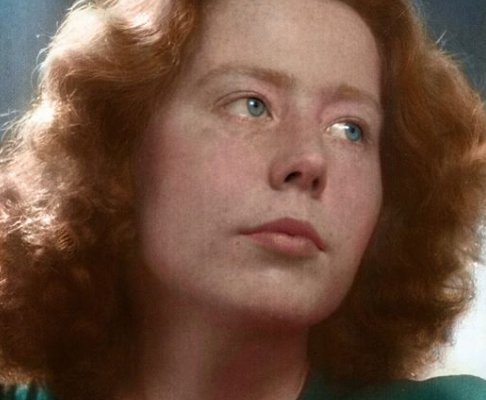Jannetje Johanna (Jo) Schaft (16 September 1920 – 17 April 1945) was a Dutch communist resistance fighter during World War II. She became known as (in Dutch Het meisje met het rode haar, also the title of a book and film about her). Her secret name in the resistance movement was Hannie.
Hannie Schaft was born in Haarlem. Her mother was a Mennonite and her father was attached to the Social Democratic Workers’ Party. During her law studies at the Universiteit van Amsterdam she became friends with the Jewishstudents Philine Polak and Sonja Frenk. This made her feel strongly about actions against Jews. With the German occupation of the Netherlands in World War II university students were required to sign a declaration of allegiance to the occupation authorities. When Hannie refused to sign the petition in support of the occupation forces, she could not continue her studies and moved in with her parents again. She became more and more active in the resistance movement and helped people who were hiding from the Germans with stolen identification cards and food-coupons.
Resistance work
he joined the Raad van Verzet (nl), a resistance movement that had close ties to the Communist Party of the Netherlands. Her motivation to join the communists was that they were at least resisting actively. With her friend Truus she carried out various attacks on Germans, collaborators and traitors. She learned to speak German fluently and got involved with German soldiers. Some resistance members considered her a traitor for that.
After a sub-department of the Raad van Verzet in Velsen killed a farmer, without authorization from the groups’ leaders, Hannie brought a list of names of the ones who did that to her leaders.
Afterwards the named people on this list were given to the Sicherheitsdienst, which meant a certain death. After the war this episode was investigated by a special commission.
Death
She was eventually arrested at a military checkpoint in Haarlem on April 17, 1945, while distributing the illegal communist newspaper de Waarheid. Although at the end of the war there was an agreement between the occupier and the Binnenlandse Strijdkrachten (nl) to stop executions, she was shot dead three weeks before the end of the war in the dunes of Bloemendaal. Two men took her there and one shot her at close range, only wounding her. She supposedly said to her executioners: “I shoot better than you”, after which the other man delivered the final shot.
Legacy
After the war, in these dunes the remains of 422 members of the resistance were found, 421 men and one woman, Hannie Schaft. She was reburied at the honorary cemetery Erebegraafplaats Bloemendaal in the dunes in Overveenin the presence of Princess Juliana and her husband Prince Bernard. Later, as queen, Juliana unveiled a bronze commemorative statue in the Kenau Park in nearby Haarlem, her birthplace. Hannie Schaft also received the ‘Wilhelmina resistance cross’ and a US decoration.
Shortly after the war, the communist movement enjoyed popularity, partly because of the effort of the USSR in defeating the Nazis. However, with that country’s increasing influence in Eastern Europe, the popularity decreased. Because the Dutch communist party celebrated her as an icon, her popularity decreased too, to the point that the commemoration at Hannie’s grave was forbidden in 1951. The commemorators (who were estimated to number over 10,000) were stopped by several hundred police and military with the aid of 4 tanks. A group of seven managed to circumvent the blockade and reached the burial ground, but were arrested when they tolled the bell. From the next year on, the communists decided to prevent another such scene by holding their commemoration in Haarlem instead.
A number of schools and streets were named after her. For her, and other resistance-heroines, a foundation has been created; the Stichting Nationale Hannie Schaft-herdenking.
A number of books and movies have been made about her. She features in De Aanslag by Harry Mulisch, also released as a movie directed by Fons Rademakers. Ineke Verdoner wrote a song about her. Author Theun de Vries wrote a biography of her life, which has inspired the movie Het Meisje met het Rode Haar (The Girl with the Red Hair) by Ben Verbong featuring Renee Soutendijk as Hannie Schaft. She is remembered each year in November during a national event held in Haarlem.
Dutch Douc Channel
Colorising: Piece of Jake











